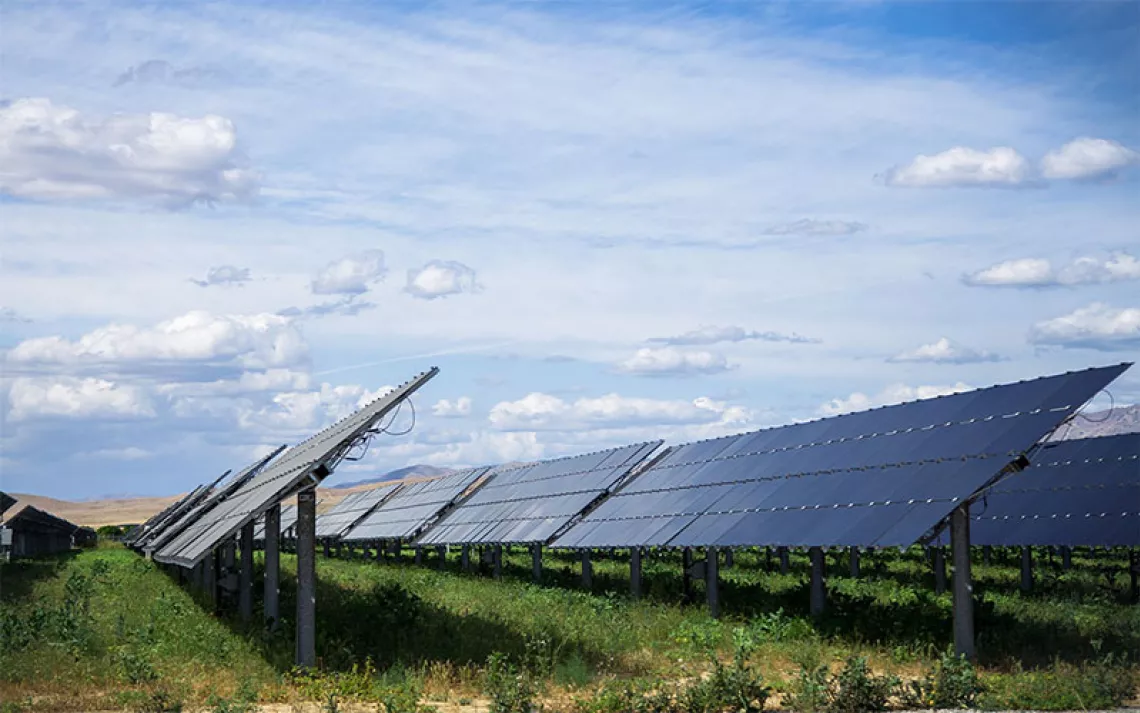Jeff Nesbit Talks About How to Talk About Climate Change
Climate Nexus executive director on communicating complex issues with the public

A boy rinses a bucket as he and others collect water from a well that is allegedly contaminated with cholera bacteria, on the outskirts of Sanaa, Yemen. | Photo by AP Photo/Hani Mohammed
In 2003, Jeff Nesbit, executive director of Climate Nexus, interviewed biodiversity expert Terry Root about her research on climate change and animal migration. The discussion was part of a video series he'd commissioned for the National Science Foundation, where he was working at the time.
To his surprise, he found himself reassuring her that her work to educate the public about the negative impacts of climate change hadn’t been in vain. "I've failed. I've tried. But I can't make people understand," she told him before breaking down on camera. The problem wasn't that some people—mostly nonscientists—questioned the validity of her work. It was that she felt "utterly incapable" of explaining the complexity of the problem in simple terms for a mass audience. Nesbit knew then that climate change communication in the United States needed work. The field needed someone like him.
Nesbit remembers this moment in his latest book, This Is the Way the World Ends: How Droughts and Die-Offs, Heat Waves, and Hurricanes are Converging on America. The book's clear and urgent prose—as well as its persuasive strategies for mitigating climate change—make the book one of the most important of the year.
It begins with an overview of the multifarious effects of climate change and how they are interconnected: the rapid melting of Himalayan ice, the global collapse of pollinator colonies, and the rise in ocean acidity. All of this, Nesbit says, can be contributed to a quickly warming planet. From there he discusses some of the reasons why climate change remains a thorny problem for world governments to tackle. He concludes with a blueprint for the future: how not only federal governments, but also local ones—along with corporate giants and grassroots activists—can work to lower greenhouse gas emissions and otherwise alleviate the impacts of climate change.
His solutions are practical and written in the style of someone who's spent a lifetime articulating complex issues to the public (Nesbit also served as a senior communications official at the White House).
Nesbit spoke to Sierra about his book, the reasons why scientists—and society in general—have such a hard time discussing climate change, and his proposed plan for mitigating global warming.
Sierra: What are we as a society fundamentally getting wrong about climate communication?
Jeff Nesbit: Early in my career I was an associate commissioner for the FDA and proposed that they regulate cigarettes. It took years to try to crack the secret equation of how we could convince teenagers to not start smoking. What we eventually learned was that threats about the future didn't change their minds. Teenagers believe they're immortal. What did ultimately work was the FDA’s campaign to help them realize that tobacco companies were targeting them, getting them hooked, and lying to them in real time. I had moved on from the FDA by the time the Truth Campaign was launched, but I watched it closely and saw that it was working because it brought the fight to the present day. When the FDA started the fight, close to 40 percent of American teenagers were smoking. Now the number is in the single digits. This experience helped me to realize that there's a direct analogy between what we communicated about tobacco and climate change. The public shares a basic belief that the worst impacts of climate change won't be felt by anyone who's living now, that it's a problem for the future. We need to communicate that it's a present threat.
What obstacles are scientists up against when trying to communicate climate change in this way?
I've worked with hundreds of thousands of scientists at this point through my work at the National Science Foundation and now Climate Nexus, and I can tell you that communication problems aren't the fault of scientists. Climate change is a difficult issue to grapple with because it's so complicated. [Scientists] are under political and economic pressure from opposing forces who don't want the science to become well known. That's the reason why I set out to write this book. I wanted to help answer the question of what kinds of significant climate impacts are being felt right now—not 20 or 50 years from now—and where they're being felt.
What in your research surprised you the most?
I've been working in [the field of climate communication] for years and years and even I was surprised by some of the things I've learned. Countries like Yemen, Saudi Arabia, China, and India are already seeing impacts that are extraordinarily severe. Let's take Yemen. Several scientists and diplomats in Yemen were yelling at the top of their lungs about climate change before the government there collapsed. They said the country was going to run out of water. They wrote reports and met with top officials. Soon we saw their predictions come true. Their freshwater aquifers ran out of water, and warlords and others took over the remaining ones; there were public health and sanitation problems. We saw the spread of diseases, and basically, society started to break down. Then, a few years later, things drifted into further chaos: The government collapsed, instances of terrorism started to happen. And it's these things that consume the media coverage. But we knew—so many people knew—that something like this was going to happen.
Why is it important for people in the United States to read about Yemen and other places around the world where climate change has already made a devastating impact?
I would argue that what happened in Yemen was one of the first harbingers of the coming water wars. True, there are very few places in the United States that are comparable to Yemen, but we are starting to see some similarities. California's Central Valley is a good example. It has an aquifer under it just like Yemen. Once it goes dry, fights over water will start to happen. People in the United States should feel very lucky that we live in a relatively moderate climate. But the problems [due to climate change] affecting other parts of the world—economic dislocation, water wars, food insecurity, severe weather events—will start to impact Americans too. They will come here and will likely come sooner rather than later.
Why does climate change remain such a political issue in the United States?
Sadly, I think the United States is becoming two countries. We argue over immigration, gun violence, abortion, you name it, and climate change is caught up in that much larger communication problem. But I do think that there are some important changes taking place. After Hurricane Harvey hit Houston, more than half of Republican voters came to understand that extreme weather events are connected to climate change. Unfortunately, I think it will take some time before this shift shows up at the elected level.
In the last third of your book you propose a blueprint for moving forward. You argue that, yes, Democrats and Republicans look at the world in fundamentally different ways, but that if we could combine the Democrats' appreciation and support for peer-reviewed science with the Republicans' belief in the power of the free market, we could actually achieve something.
I really believe that's true. When you get beneath the surface of political rhetoric, you can see that one half to two-thirds of Republican voters understand the urgency of climate change. What's keeping them from raising their voices inside of their own party is that they're going through an existential crisis over Donald Trump. As long as they stay the Donald Trump party, they're going to have a tough time taking significant action. But I believe that could change very quickly. I think we could have a mostly bipartisan national climate policy in place as early as 2020 or 2021. One reason for this is that most CEOs of big companies now recognize the reality of climate change and its potential impacts on supply chains and other aspects of business.
Can you talk more about this? What role are big businesses playing in the movement to do something about climate change?
I don't write about this in the book, but soon after President Trump announced that he was withdrawing the United States from the Paris Agreement, several organizations launched the We Are Still In movement, organized in part by Climate Nexus, to continue reducing carbon emissions. So far, we've had hundreds of CEOs who've signed the pledge and we're still working to add more. We just added 800 hospital systems. Trump's withdrawal from the agreement galvanized real action in the business community.
You write persuasively in the book that a carbon tax could be an important part of a plan to address climate change.
Yes, that's because we really only have two choices if we want to fundamentally disrupt the energy system on Earth. One way is to control emissions. The other is to disrupt the entire energy economy. The best and easiest way to do that is to offer a big enough financial incentive to convince people who are emitting carbon to shift to something else, to something that will make them more money. The Koch political network is set against any new tax, so they will fight this idea to the death. But they don't speak for industry in America. A carbon tax, or carbon price—they actually have different meanings within the regulatory and tax economy—could unleash a low-carbon economy that generates new revenue.
Are you personally hopeful for the future?
I am, actually. I believe we're witnessing the death of the internal combustion engine right now. Historians will look back at this point in time and see the birth of the technology industry and rapid growth of solar utility industries. Energy in the next 10 years won't look anything like what it looks like now; either will the transportation sector. In presentations I like to show two side-by-side pictures of the Thanksgiving parade on Fifth Avenue in New York City in the early 20th century. In one picture, everyone's on horses or in horse-drawn carriages. Just five years later, they're all in cars. Change can happen very quickly.
 The Magazine of The Sierra Club
The Magazine of The Sierra Club



